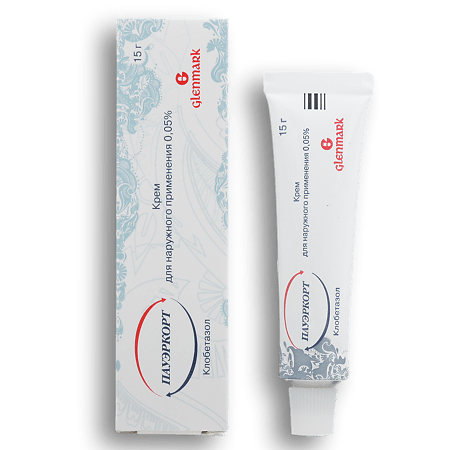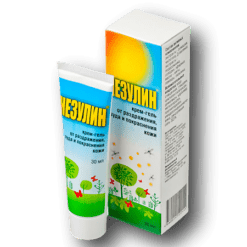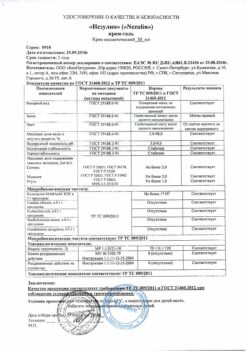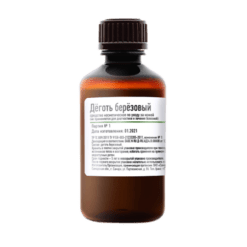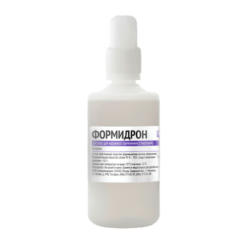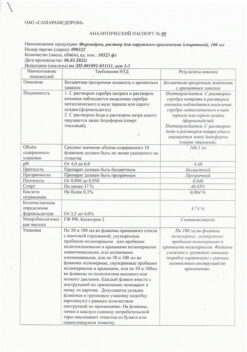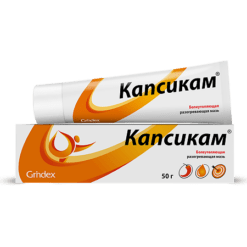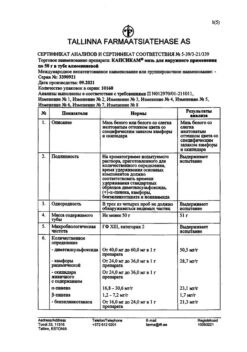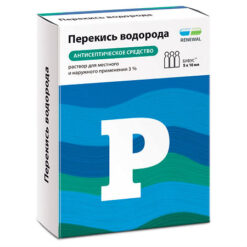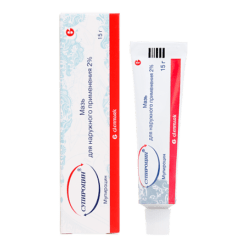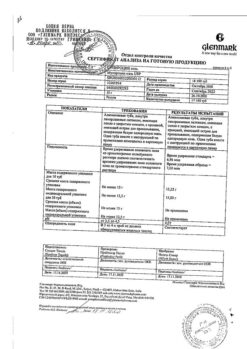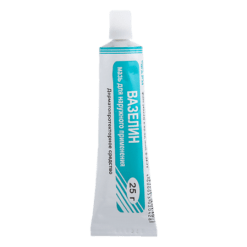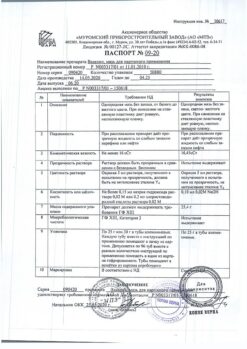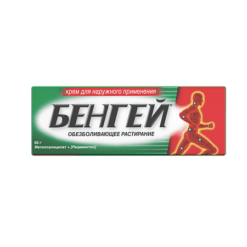No products in the cart.
Powercourt, 0.05% cream 15 g
€21.84 €18.20
Description
Mechanism of action
The glucocorticosteroid for external use.
Prevents marginal accumulation of neutrophils reduces inflammatory exudation and production of lymphokines inhibits macrophage migration reduces the intensity of infiltration and granulation processes has local anti-inflammatory antipruritic anti-allergic and anti-exudative effects.
Pharmacokinetics:
Indications
Indications
Clobetasol is a very strong glucocorticosteroid that is indicated for the short-term treatment of symptoms of inflammation and skin itching in dermatoses that are sensitive to glucocorticosteroid therapy and are unresponsive to less potent glucocorticosteroids (for elderly adults and children over 1 year of age):
psoriasis (excluding widespread plaque psoriasis);
dermatoses that are difficult to treat;
lichen planus;
discoid lupus erythematosus;
other skin diseases resistant to therapy with less potent glucocorticosteroids.
Pharmacological effect
Pharmacological effect
Mechanism of action
Glucocorticosteroid for external use.
Prevents the marginal accumulation of neutrophils, reduces inflammatory exudation and the production of lymphokines, inhibits the migration of macrophages, reduces the intensity of infiltration and granulation processes, has local anti-inflammatory, antipruritic, antiallergic and antiexudative effects.
Pharmacokinetics:
Special instructions
Special instructions
The drug Powercourt should be used with caution in patients with a history of local hypersensitivity to glucocorticosteroids or to any excipient included in the drug.
Local hypersensitivity reactions may be similar to the symptoms of an ongoing disease. In some individuals, as a result of increased systemic absorption of glucocorticosteroids for external use, manifestations of hypercorticism (Cushing’s syndrome) and reversible inhibition of the hypothalamic-pituitary-adrenal system may occur, leading to the development of glucocorticosteroid insufficiency.
If any of the above occurs, the drug should be discontinued, gradually reducing the frequency of its application, or replaced with a less active glucocorticosteroid. Sudden cessation of treatment may lead to the development of glucocorticosteroid deficiency.
Risk factors for increased systemic effects include: the activity of the glucocorticosteroid and the composition of the drug for external use, the duration of use, application of the drug to large areas of the skin, use in closed areas of the skin (i.e., in intertriginous areas or under occlusive dressings (diapers and nappies in infants can play the role of an occlusive dressing)) increased hydration of the stratum corneum of the skin, use on areas with thin skin such as the face; application to damaged skin or other conditions that may be accompanied by a violation of the integrity of the skin barrier.
Compared with adults, children and infants may experience a greater percentage of absorption of topical glucocorticosteroids, and therefore this category of patients is more at risk of developing systemic side effects. This is due to the fact that children have an immature skin barrier and a higher ratio of body surface area to body weight compared to adults.
Use in children
If possible, long-term treatment with topical glucocorticosteroids should be avoided in children under 12 years of age, as long-term use of topical glucocorticosteroids may cause suppression of adrenal function.
In children, more often than in adults, atrophic skin changes occur with external use of glucocorticosteroids. If clobetasol is prescribed to children, the course of treatment should be limited to 5 days; observation by a doctor is required at least once a week. Do not use occlusive dressings.
Use for psoriasis
In some cases, treatment of psoriasis with glucocorticosteroids for external use may be accompanied by a resumption of symptoms of the disease with resistance to the drug, the development of a generalized pustular form of psoriasis and local or systemic toxicity due to a violation of the skin barrier function; therefore, careful monitoring of the patient is especially important.
Concomitant infection
If a secondary infection occurs, appropriate antibacterial therapy should be carried out. If there are any signs of infection spreading, it is necessary to stop the external use of glucocorticosteroids and carry out appropriate treatment with antibacterial drugs.
Risk of infection due to occlusion
The warm, moist conditions created when applying an occlusive dressing are conducive to bacterial infection, so be sure to thoroughly clean the skin before applying a new dressing.
Chronic leg ulcers
Topical corticosteroids are sometimes used to treat dermatitis around chronic leg ulcers. However, such use may be accompanied by an increased incidence of local hypersensitivity reactions and an increased risk of local infections.
Application to facial skin
Application to the skin of the face is undesirable as this area is more susceptible to the development of atrophic changes.
If applied to the face, treatment should be limited to 5 days.
Application on eyelids
When applying the cream to the eyelids, it is necessary to ensure that the drug does not get into the eyes because repeated exposure to the cream can cause cataracts and glaucoma. If the drug accidentally gets into your eyes, rinse them with plenty of water.
Impact on the ability to drive vehicles. Wed and fur.:
Active ingredient
Active ingredient
Clobetasol
Composition
Composition
Active ingredient:
– clobetasol propionate 0.05 g.
Excipients:
paraffin (soft, white);
liquid paraffin;
cetomacrogol;
sodium phosphate monohydrate;
sodium phosphate dihydrate;
butylated hydroxytoluene;
methyl parahydroxybenzoate;
propyl parahydroxybenzoate;
propylene glycol;
purified water.
Pregnancy
Pregnancy
Fertility
There are no data available to evaluate the effects of topical corticosteroids on fertility in humans. When administered subcutaneously to rats, clobetasol had no effect on mating ability; however, when administered in high doses, a decrease in fertility was noted.
Pregnancy
There is insufficient data on the use of clobetasol in pregnant women.
According to preclinical studies, clobetasol may adversely affect fetal development.
The significance of these data in humans has not been studied.
The drug should be used during pregnancy only if the potential benefit to the mother outweighs the possible risk to the fetus.
If the drug is prescribed during pregnancy, a minimal amount of cream should be used for a minimally short time.
Breastfeeding period
The use of the drug during breastfeeding is contraindicated.
Contraindications
Contraindications
Hypersensitivity, rosacea and acne acne, perioral dermatitis, bacterial, viral and fungal skin infections, genital and perianal itching, pregnancy and breastfeeding, children (up to 1 year).
Side Effects
Side Effects
Externally.
The cream is recommended for use for skin lesions accompanied by weeping.
The cream is applied in a thin layer in an amount no greater than required to cover the entire affected area once or twice a day and gently rubbed in. Duration of use – until the effect appears or, if necessary, up to 4 weeks. Treatment should not be carried out for more than 4 weeks. If long-term treatment is necessary, the frequency of application should be gradually reduced or less active drugs should be used. After each application of Powercourt, allow sufficient time for absorption before applying the emollient.
To prevent exacerbations of skin diseases, short (intermittent) courses of Powercourt are administered.
In particularly resistant cases, especially in the presence of hyperkeratosis, the effect of the cream for external use Powercourt, if necessary, can be enhanced by applying an occlusive dressing (plastic film) to the area of application at night, which is usually accompanied by a positive dynamics of symptoms. In the future, the achieved effect can usually be maintained without the use of an occlusive dressing.
If the condition worsens or does not improve within 2-4 weeks, the diagnosis and treatment should be reconsidered. The maximum dose should not exceed 50 g of cream per week.
Treatment with Powercourt should be gradually withdrawn as soon as disease control is achieved and treatment with an emollient should be continued as maintenance therapy.
Sudden withdrawal of Powercourt may lead to relapse of previously existing dermatoses.
Application on the face
The course of treatment should be limited, if possible, to 5 days; Occlusive dressings should not be used.
Dermatoses that are difficult to treat: patients with frequent relapses of the disease
In the case of an acute illness, as soon as the effect of a continuous course of treatment with a glucocorticosteroid for external use is achieved, the possibility of its intermittent use (once a day, twice a week without an occlusive dressing) can be considered. This treatment has been shown to effectively reduce the incidence of relapses. Application of the drug should be continued to all previously affected areas of the skin or to known areas of potential exacerbation. This regimen should be combined with routine daily use of emollients. The condition and the benefits and risks of continuing treatment should be regularly assessed.
Special patient groups
Children
Children are more likely to develop local and systemic side effects when treated with topical corticosteroids and generally require shorter courses of treatment using less active agents than adults.
Caution should be exercised when using Powercourt in children to ensure that it is applied in a minimal amount to ensure a therapeutic effect.
The course of treatment in children should be limited, if possible, to 5 days; Observation by a doctor is required at least once a week. Occlusive dressings should not be used.
Elderly patients
Clinical studies have not revealed any differences in the effectiveness of the drug in older and younger patients. The high prevalence of reduced liver or kidney function in elderly patients may lead to a slower elimination of the drug if it is systemically absorbed. Therefore, it should be used in elderly patients in minimal quantities and for the shortest possible period while still achieving the required clinical effect.
Patients with impaired renal and/or liver function
If the drug is systemically absorbed (when applied to large areas of the skin over an extended period), its metabolism and elimination may be slowed, leading to an increased risk of systemic toxicity. Therefore, it should be used in such patients in a minimal amount and for the shortest possible period while still achieving the required clinical effect.
Interaction
Interaction
It has been shown that the simultaneous use of drugs capable of inhibiting the CYP3A4 isoenzyme (for example, ritonavir and itraconazole) inhibits the metabolism of glucocorticosteroids, leading to an increase in their systemic exposure. The degree of clinical significance of this interaction depends on the dose and route of administration of glucocorticosteroids and the activity of the CYP3A4 isoenzyme inhibitor.
Overdose
Overdose
Symptoms and signs
The drug Powercourt, when applied externally, can be absorbed in quantities sufficient to cause the development of systemic effects. The development of an acute overdose is unlikely. However, in case of chronic overdose or improper use of the drug Powercourt, symptoms of hypercortisolism may develop.
Treatment
In case of an overdose of Powercourt, the drug should be gradually discontinued by reducing the frequency of application or replacing it with a less active glucocorticosteroid under medical supervision due to the risk of adrenal insufficiency.
Further treatment should be based on the clinical situation or in accordance with the recommendations of poison control centers, if available.
Storage conditions
Storage conditions
In a place protected from light at a temperature not exceeding 25 ° C.
Keep out of the reach of children.
Shelf life
Shelf life
2 years.
Do not use the drug after the expiration date.
Manufacturer
Manufacturer
Glenmark Pharmaceuticals Ltd, India
Additional information
| Shelf life | 2 years. Do not use after the expiration date. |
|---|---|
| Conditions of storage | In the dark place at a temperature not exceeding 25 °С. Store out of the reach of children. |
| Manufacturer | Glenmark Pharmaceuticals Ltd, India |
| Medication form | exterior cream |
| Brand | Glenmark Pharmaceuticals Ltd |
Related products
Buy Powercourt, 0.05% cream 15 g with delivery to USA, UK, Europe and over 120 other countries.

